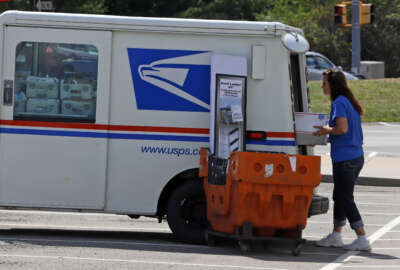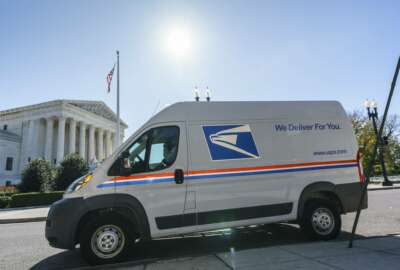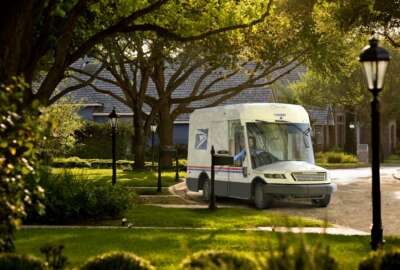Vendor on USPS vehicle contract shortlist ends bid protest over award
Workhorse Group, an electric vehicle company on the Postal Service's shortlist to manufacture its next-generation delivery vehicle fleet, is ending its legal battle...
Workhorse Group, an electric vehicle company on the Postal Service’s shortlist to manufacture its next-generation delivery vehicle fleet, is ending its legal battle against USPS and contract award recipient Oshkosh Defense.
Workhorse withdrew its bid protest Tuesday, a day before oral arguments were scheduled before the U.S. Court of Federal Claims.
The vendor filed its bid protest in June, arguing that USPS “put its thumb on the scale against Workhorse” and took its prototype out of consideration over a “safety incident” caused by a USPS test track driver’s error.
Workhorse also alleges Oshkosh Defense, the USPS vehicle award recipient, submitted a prototype vehicle “entirely different” than the one selected for production, and that the winning design from Oshkosh Defense “skipped the prototype phase altogether.”
Attorneys for USPS and Justice Department asked the court to dismiss Workhorse’s case in July, on the grounds that the vendor failed to exhaust all of its administrative appeal options before filing its bid protest.
After USPS awarded the contract to Oshkosh Defense, DoJ attorneys said Workhorse sent a disagreement letter to USPS’ contracting officer, who then “issued a detailed response letter denying Workhorse’s disagreement.”
If Workhorse was unsatisfied with the contracting officer’s decision, DoJ attorneys said it could have filed a complaint with the supplier disagreement resolution official (SDR), but DoJ said the vendor didn’t do that.
“Workhorse has indisputably failed to exhaust administrative remedies required by application Postal Service regulations. As a result, the court must dismiss this case,” DoJ attorneys wrote.
Oshkosh Defense attorneys said that rather than appeal to the SDR official, Workhorse “sat idle for three months” before moving forward with its bid protest.
Oshkosh Defense also argued both its electric and fossil fuel-powered prototypes were more cost-effective and “technically superior” to the prototype vehicles submitted by other contractors, including Workhorse.
Oshkosh Defense’s attorneys said USPS ranked Workhorse’s electric battery-powered design last, both in terms of technical ranking — the most important criteria in making the award — and in terms of best value.
In contrast to Workhorse’s all-electric vehicle proposal, Oshkosh Defense told the court it “proposed a more flexible approach that utilized an internal-combustion-engine vehicle in the near term with the option to transition to an electric vehicle in the medium to long term.”
Workhorse, however, said the Postal Service’s private-sector competitors are “aggressively moving toward all-electric, zero-emissions fleets” to save money.
USPS, meanwhile, faces pressure from Congress and the Biden administration to get more electric vehicles on delivery routes.
The House Oversight and Reform Committee earlier this month approved giving USPS more than $7 billion, as part of a $3.5 trillion budget reconciliation package, to purchase more electric vehicles in its next-generation fleet.
The committee also approved giving the General Services Administration $5 billion to purchase more than 160,000 electric vehicles and set up charging stations.
The infrastructure spending would help meet some of the goals set by President Joe Biden, who signed an executive order in his first month in office directing agencies to move the entire federal vehicle fleet to electric and zero-emission vehicles. Electric vehicles currently make up less than 1% of the federal fleet.
USPS owns about a third of all federal vehicles, and ranks second only to the Defense Department in terms of agencies with the largest vehicle inventory.
The funding comes close to what USPS previously asked from Congress. Postmaster General Louis DeJoy told lawmakers in March that USPS needed $8 billion to electrify the fleet “in a shorter time frame to the maximum extent that is operationally feasible.”
DeJoy initially told Congress that only 10% of its new fleet would be electric vehicles, but later told lawmakers that figure was “a floor — not a ceiling — based upon our current financial situation.”
USPS in its 10-year reform plan expects to make a majority of its fleet electric within 10 years “with the right level of congressional support,” and become fully electric by 2035.
However, DeJoy told lawmakers electric vehicles will be more expensive to purchase than those that run on fossil fuels, and will require additional spending to build charging stations,
Electric vehicles also don’t currently meet all of the Postal Service’s needs. DeJoy told lawmakers there are as many as 12,500 postal routes in the country where the distance driven, environmental conditions or facility limitations would make electric vehicles “unfeasible or impractical.”
Copyright © 2025 Federal News Network. All rights reserved. This website is not intended for users located within the European Economic Area.
Jory Heckman is a reporter at Federal News Network covering U.S. Postal Service, IRS, big data and technology issues.
Follow @jheckmanWFED






